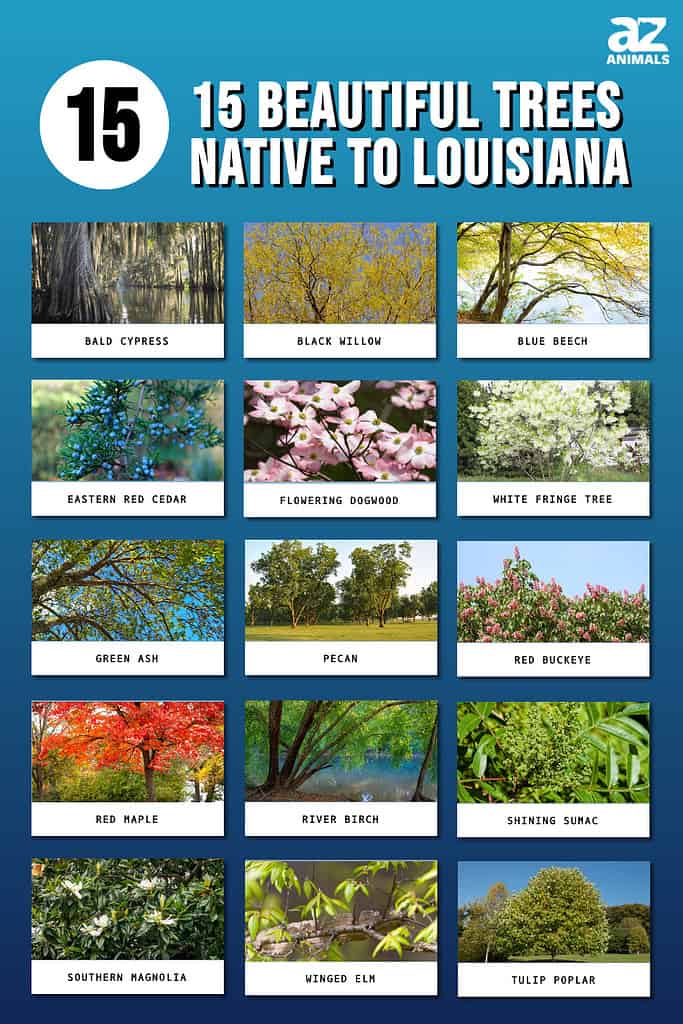
Native trees to Louisiana, such as the bald cypress, eastern hemlock, and sweet bay magnolia, provide numerous benefits to local wildlife. By incorporating these trees into your yard or garden, you can help improve drainage in the area, provide additional shade for plants that need it, and create a habitat for pollinators and other wildlife.
Bees are often adapted to life in prairies rather than forests. However, they can still benefit from the resources provided by flowering native trees in a landscape designed with pollinator-friendly elements like nectar-rich flowers. Native trees also host plant species that attract beautiful native butterflies and moths, which can be beneficial insect predators of unwanted pests in the garden. If you live in Louisiana, incorporating these trees will enhance your landscaping and help support local ecosystems!
Bald Cypress

Bald cypress trees are often found growing in wet, swampy areas of Louisiana.
©lazyllama/Shutterstock.com
The bald cypress (Taxodium distichum) is a beautiful deciduous conifer and the official state tree of Louisiana. It is often found growing in wet, swampy areas and can reach heights over 100 feet tall with trunks up to 6 feet wide. Bald Cypress trees are known for their distinctive “knees,” which protrude when the tree is submerged in shallow waters.
Bald cypress trees provide shelter and nesting sites for wildlife, especially fish such as bass and bream that seek refuge beneath them during dry spells. The branches offer food sources for birds, squirrels, insects, and other animals while providing important shade on hot days. The leaves also play an important role in filtering pollutants from local waterways, helping improve the water quality of nearby streams and rivers.
Black Willow

They provide pollen at crucial times throughout the year when female bees gather food for their nests.
©Sue Burton Photography/Shutterstock.com
Black willow (Salix nigra) is a tree species native to Louisiana and is especially beneficial to the local bee population. Not only does it provide pollen, but it provides it at crucial times throughout the year when female bees gather food for their nests in preparation for winter. The tree’s bark also houses larvae of various types of insects, including honeybees, making them an essential part of the ecosystem. Furthermore, black willows can grow quite tall (100 feet) and provide good nesting spots for birds and shade during hot days.
Blue Beech

These hardy trees are also called American Hornbeams.
©Gerry Bishop/Shutterstock.com
Blue beech (Carpinus caroliniana) is a deciduous tree native to Louisiana and other parts of North America. It is also known as the American hornbeam or ironwood tree due to its hard, dense wood that has been used in furniture crafting. Growing up to 30-50 feet tall, blue beech can be identified by its blue-gray bark and leaves that are sharply serrated at the edges. The small flowers bloom in April and May, with greenish-yellow catkins appearing later.
In addition to being lovely to look at, this species offers several benefits for local wildlife. They provide food for squirrels and rabbits from fruits and nuts, nesting spots for birds within its dense foliage, habitat protection from predators, and pollen sources for bees and butterflies.
Eastern Red Cedar
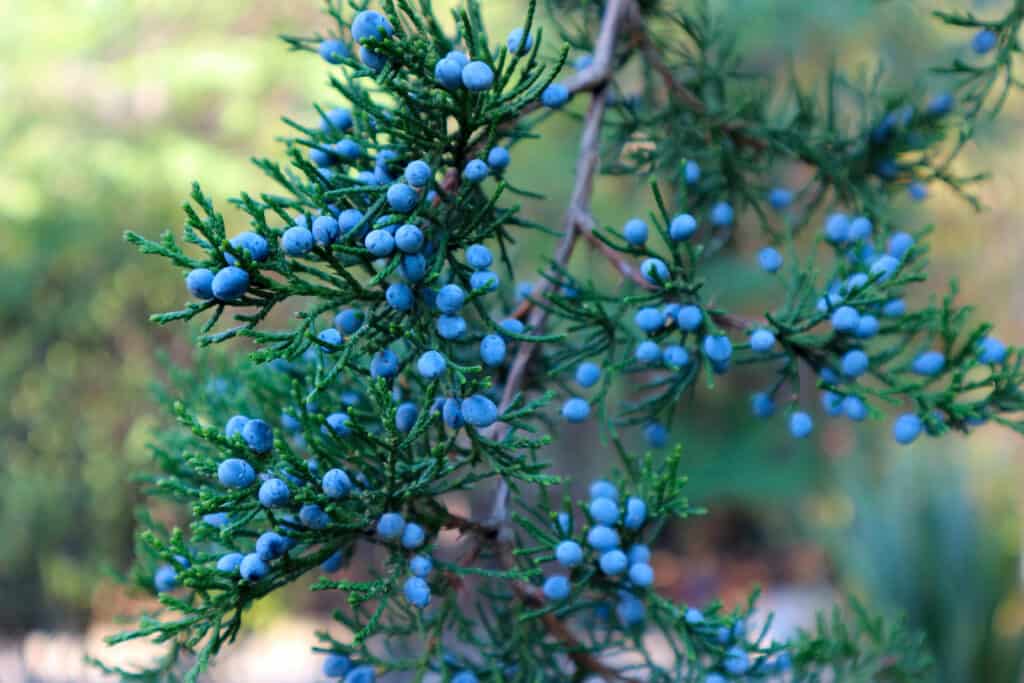
Delightfully blue juniper berries grow on eastern red cedars.
©iStock.com/Lyudmila Chetvertnykh
Eastern red cedar (Juniperus virginiana) is a medium-sized evergreen tree native to the northern parts of Louisiana. It grows up to 60 feet tall and can live for up to 500 years, making it one of the longest-living trees in North America. The foliage of this tree is dark green and features tiny needle-like leaves that stay on the twig all year round.
This tree provides bird nesting areas and an important food source in the form of delightfully blue juniper berries. Its dense canopy also provides shade during hot summer days, which helps keep the environment cool while providing a habitat for insects like butterflies and bees. Eastern red cedar wood is durable and rot-resistant, making it an excellent choice for outdoor furniture or structures like fences, trellises, or pergolas.
Flowering Dogwood

Dogwoods are an excellent choice for adding beauty to any landscape, with their showy white and pink spring flowers.
©iStock.com/JillLang
The flowering dogwood (Cornus florida) is a deciduous tree native to Louisiana and other areas in the southeastern United States. It is an excellent choice for adding beauty to any landscape, with its showy white and pink spring flowers, bright red fall foliage, and attractive bark.
This tree provides valuable food sources for local animals and insects, including birds. Its fruits are enjoyed by numerous bird species, such as cardinals, cedar waxwings, finches, blue jays, and woodpeckers, while its buds provide sustenance for squirrels during winter. Butterflies rely on the nectar from the flower clusters, while bees visit both the flowers and leaves looking for pollen. Flowering dogwood trees are hardy plants that are easy to grow in most soil types when given adequate moisture; they can reach heights up to 33 feet tall at maturity, making them a great addition to larger gardens or landscapes where space allows.
White Fringe Tree
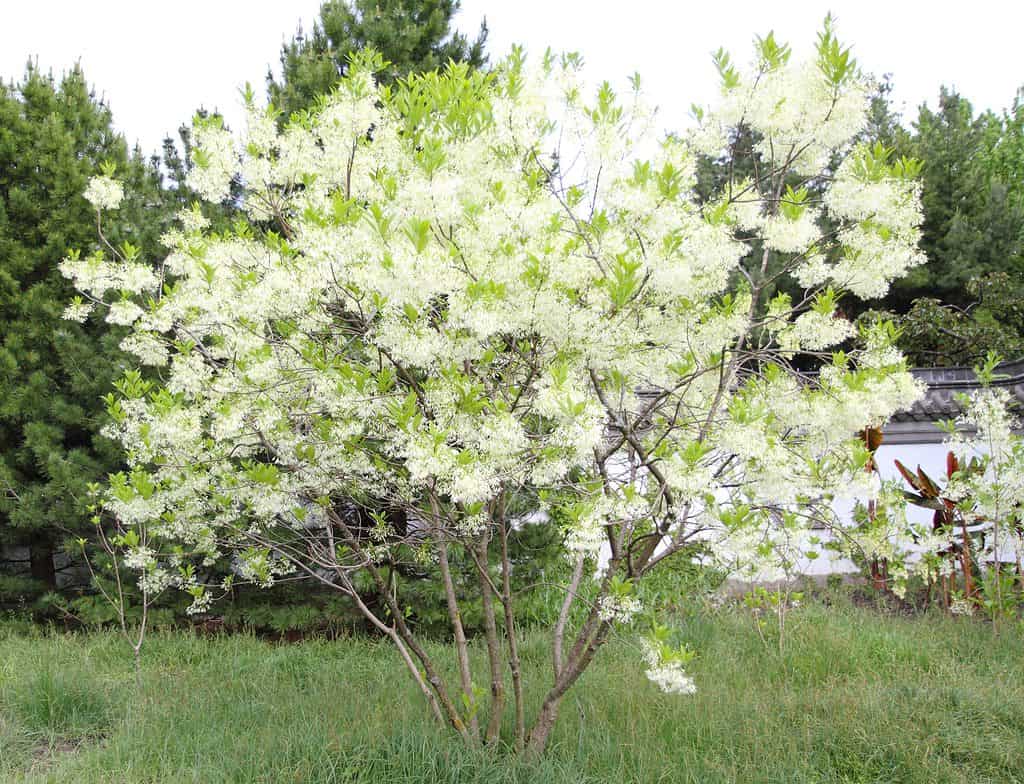
This tree produces clusters of richly fragrant white flowers in late spring that attract pollinators.
©Cephas/CCBY3.0 – License
The white fringe tree (Chionanthus virginicus) is a small to medium-sized deciduous flowering tree native to the southeastern United States, including Louisiana. It generally grows between 15-36 feet tall and has scaly bark that is brownish red.
This tree produces clusters of richly fragrant white flowers in late spring that attract pollinators such as bees, butterflies, and hummingbirds. These flowers give way to bluish-black fruits in fall, enjoyed by birds such as blue jays and mockingbirds. This tree also provides cover for animals during harsh weather conditions or when they need somewhere safe to hide from predators.
Green Ash
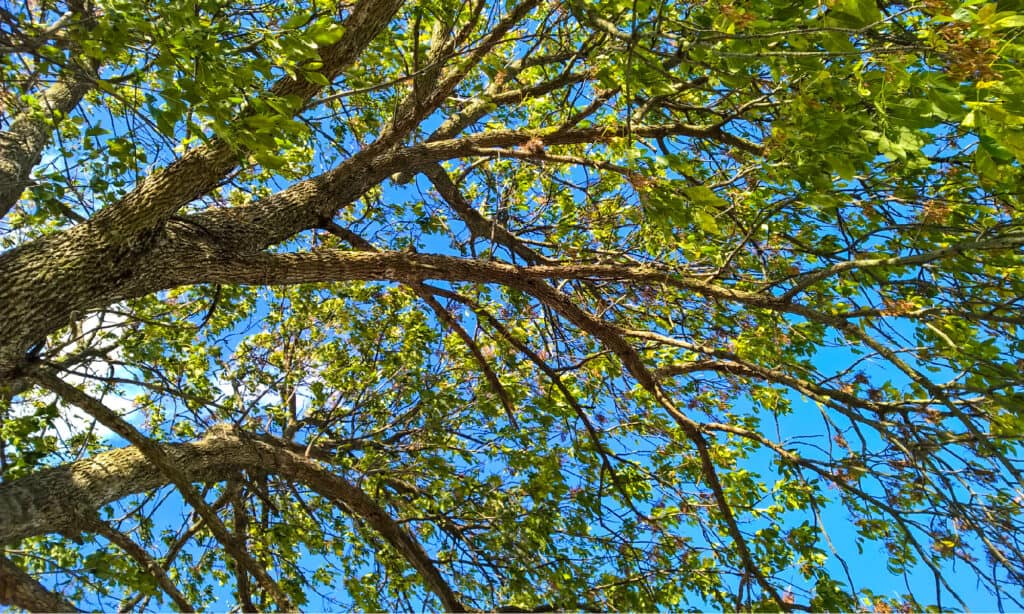
The green ash tree is also known as red ash, swamp ash, and water ash.
©iStock.com/Ethan R.
Green ash (Fraxinus pennsylvanica) is a large deciduous tree that can reach heights of up to 80 feet with a spread of 45 feet. The bark on the trunk is grayish brown, scaly, and furrowed with age. Green ash trees produce small yellow-green flowers in the spring, followed by clusters of winged seeds which mature in late summer or early fall. They prefer moist soils and commonly grow near streams. Other names for this tree are red ash, swamp ash, and water ash.
In Louisiana, they provide an important food source for many animals such as deer, rabbits, squirrels, chipmunks, and birds like woodpeckers, which feed on their nutlike fruits during winter months. But green ash trees are especially useful to frogs; when the leaves fall into a pond or puddle, they make the perfect food for growing tadpoles. These trees also support multiple species of insects, including cabbage butterflies whose larvae become moths that help control pests like gypsy moths in nearby forests.
Pecan
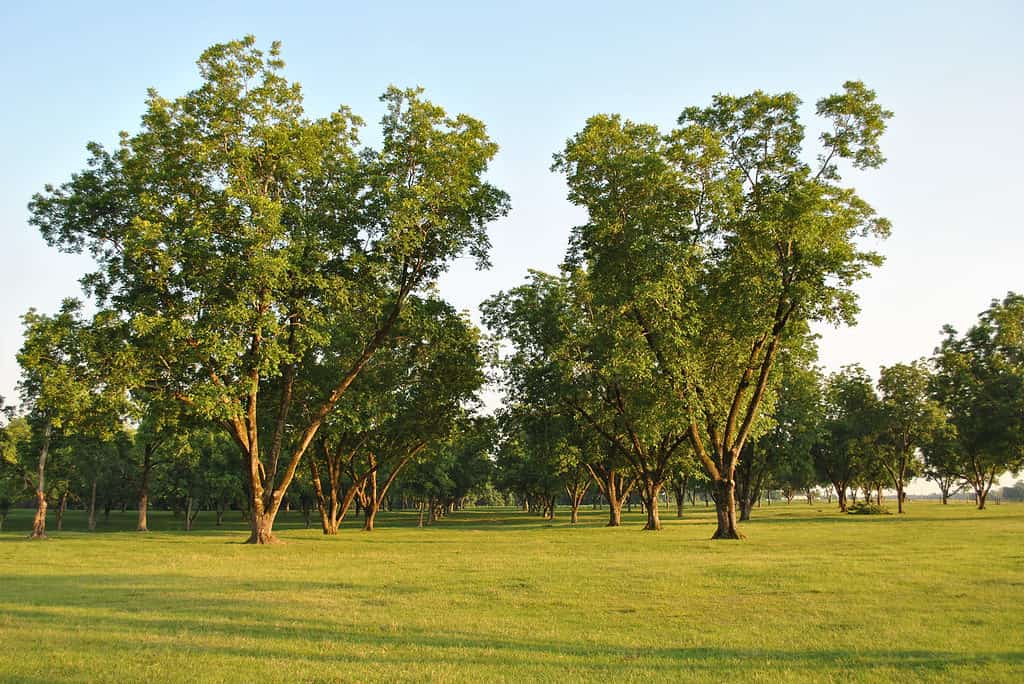
It’s quite common to find these majestic trees growing in groves throughout the state.
©Tayloradempsey/Shutterstock.com
Pecan (Carya illinoinensis) is a type of hickory tree native to the southern United States, including Louisiana. It grows best in USDA hardiness zones 5 through 9 and can live up to 300 years when properly cultivated. It’s quite common to find these majestic trees growing in groves throughout the state.
The pecan tree produces edible nuts that are valued by both wildlife and humans alike. Many animal species, such as squirrels, rabbits, deer, foxes, skunks, and birds, rely on these nuts as an important food source. And a southern holiday wouldn’t be complete without a fresh pecan pie! Pecan trees also provide shelter and habitat for various insects, which help pollinate nearby plants.
Red Buckeye
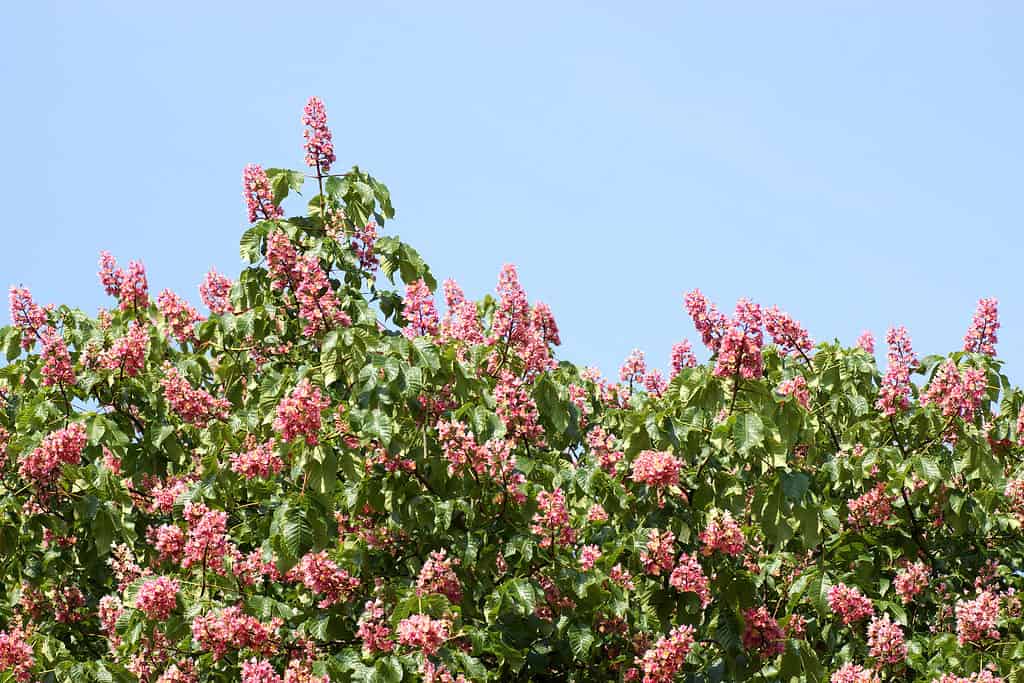
The red buckeye earned the nickname ‘firecracker plant,’ due to its stunning red flowers that appear during late spring.
©Bildagentur Zoonar GmbH/Shutterstock.com
Red buckeye (Aesculus pavia) is a large shrub or small tree native to the southeastern side of the United States, including Louisiana. It has earned the nickname ‘firecracker plant,’ due to its stunning red flowers that appear during late spring.
The nectar-rich flowers attract many pollinators, such as hummingbirds, bees, butterflies, and moths. Red buckeyes are also a great source of food for birds, squirrels, and other wildlife during the fall season when they bear fruits with seeds inside them. These trees provide shelter from harsh weather conditions and nest sites for birds like woodpeckers and owls, who often use cavities in their trunks or branches to build nests.
Red Maple

In autumn, the bright scarlet foliage of the red maple is a gorgeous sight to behold!
©iStock.com/JUN DONG
Red maple (Acer rubrum) is a large deciduous tree growing throughout Louisiana. It is often called water maple or swamp maple because it grows best in wetter soils but tolerates drier conditions. Nearly every part of the red maple is some degree of red, including the petioles, twigs, and seeds. In autumn, the bright scarlet foliage is a gorgeous sight to behold.
Red maple leaves provide food for various animals, such as elk, deer, rabbits, and squirrels. Its flowers are visited by bees and butterflies looking for nectar. Larvae of the rosy maple moth love to eat the leaves of red maple trees. Be advised that red maple leaves are highly toxic to horses, especially when the leaves are dead or wilted.
River Birch

These deciduous trees thrive in wet conditions.
©Gerry Bishop/Shutterstock.com
River birch (Betula nigra) is a deciduous tree native to Louisiana. It grows in wet soils, so you often see it near rivers and streams. River birch has an attractive exfoliating bark that ranges from salmon pink when young to reddish-brown with age. The leaves are dark green on top and light yellow-green underneath. The catkins of this species emerge early in spring before the foliage appears and are followed by small nutlets, which mature late summer into early fall.
Many birds love river birch trees. Waterfowl use the tree as a nesting site, and ruffed grouse and wild turkeys love to munch on the seeds. Deer eat many parts of this tree, as do several species of butterflies. The river birch’s beautiful bark makes it especially prized as an ornamental tree, along with other cultivars of birch with varying shades of bark.
Shining Sumac

The shining sumac, with its bright green leaves, is also known as the winged sumac.
©Kathy Clark/Shutterstock.com
Shining sumac (Rhus copallinum) is a deciduous tree or shrub native to Louisiana and can be found in the wild along roadsides, woodlands, and open fields. This plant grows up to 18 feet tall with shiny green foliage that turns bright orange-red in the fall. It spreads by underground runners and can form a dense thicket in no time.
Its clusters of small yellow flowers attract butterflies and bees. The fruits are edible for birds and are especially loved by grouse, wild turkeys, and songbirds.
Southern Magnolia
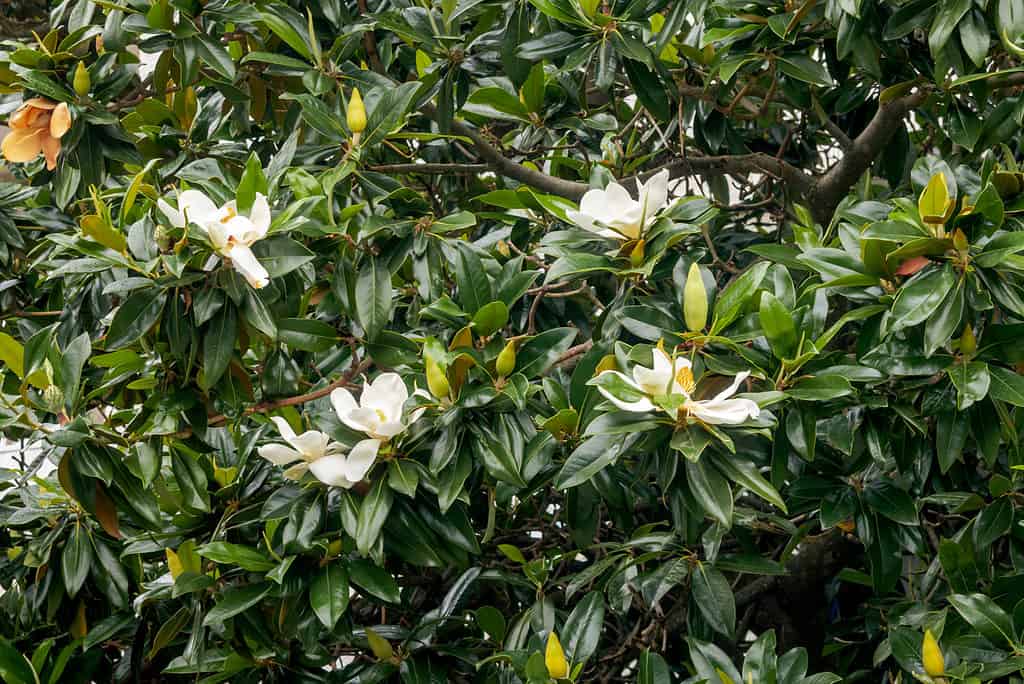
The southern magnolia’s fragrant white blooms smell of lemon citronella.
©Nick Pecker/Shutterstock.com
Southern magnolias (Magnolia grandiflora) are native to Louisiana and can be found in many parts of the state. This majestic tree has a single trunk and grows in a lovely pyramidal shape. The leaves are dark green and leathery.
The most spectacular feature of this magnificent tree is its fragrant white flowers with a strong lemon citronella scent. These blooms attract birds, butterflies, and bees, who rely on them for food. Squirrels, possums, quail, and turkeys are all big fans of magnolia seeds.
Winged Elm

These trees are popular for their shade-giving qualities and attractive foliage.
©Melinda Fawver/Shutterstock.com
The winged elm (Ulmus alata) is a deciduous tree native to Louisiana and the southeastern United States. It has shallow, fibrous roots and an open-branched crown that grows up to 40 feet tall. The name winged elm comes from the recognizable pair of corky wings that form on the branches after the tree is a couple of years old. The leaves turn yellow in the fall.
The winged elm produces small greenish flowers in spring, which eventually become winged fruit capsules containing several seeds each. These trees are popular for their shade-giving qualities and attractive foliage. Winged elms provide important habitats for local birds and insects such as bees, butterflies, spiders, ants, beetles, and moths.
Tulip Poplar
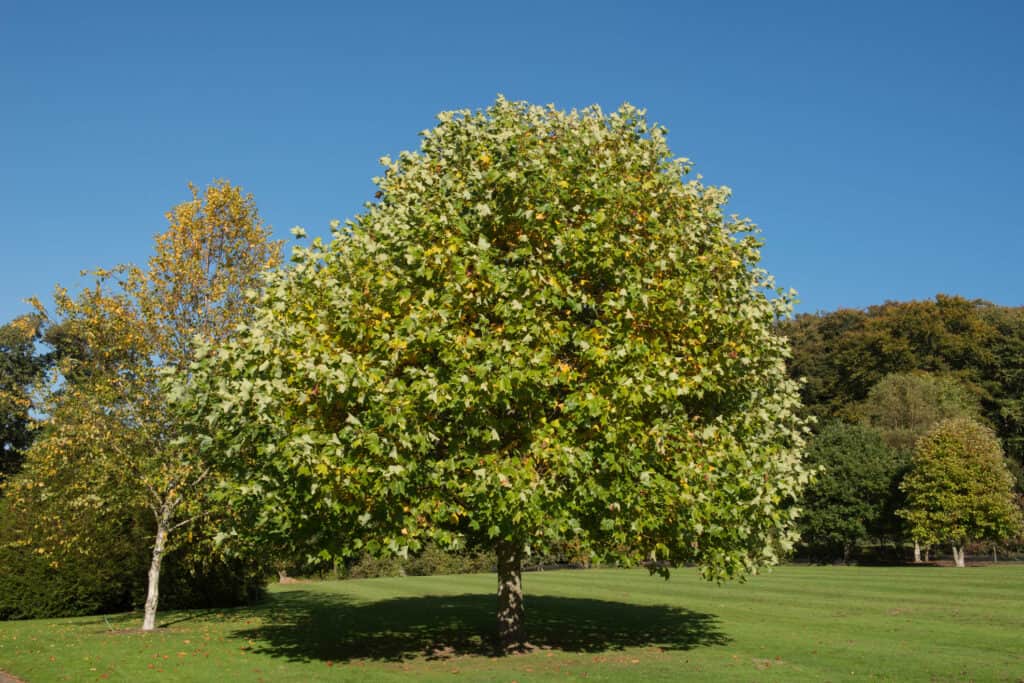
The tulip poplar is a fast-growing tree and can easily reach 100 feet.
©iStock.com/pcturner71
The tulip poplar (Liriodendron tulipifera) is a large tree native to Louisiana and the entire eastern United States. It is a fast-growing tree and can easily reach 100 feet. The bark of the tulip poplar is often covered in shallow ridges that are reddish brown. This tree has many names, including tulip tree, fiddle tree, and whitewood.
Tulip poplar produces yellow-green flowers in the cup shape of a tulip. The flowers have an unmistakable spicey fragrance. This tree is a host for many insects, including 28 species of moths! The giant silk moth and eastern tiger swallowtail find this tree the perfect place to lay their eggs.
Summary of 15 Beautiful Trees Native to Louisiana
| Rank | Species |
|---|---|
| 1 | Bald Cypress |
| 2 | Black Willow |
| 3 | Blue Beech |
| 4 | Eastern Red Cedar |
| 5 | Flowering Dogwood |
| 6 | White Fringe Tree |
| 7 | Green Ash |
| 8 | Pecan |
| 9 | Red Buckeye |
| 10 | Red Maple |
| 11 | River Birch |
| 12 | Shining Sumac |
| 13 | Southern Magnolia |
| 14 | Winged Elm |
| 15 | Tulip Poplar |
NEXT UP…
- 12 Incredible Trees Native to Maryland
- 9 Native Plants in Hawaii
- Discover the Deadliest Animals in Louisiana
The photo featured at the top of this post is © anthony heflin/Shutterstock.com
Sources
- LSU ag Center, Available here: https://www.lsuagcenter.com/NR/rdonlyres/F5E6FA92-D84F-4716-9176-355A62765838/18167/pub2926NativeTreeGuide.pd
- LSU.edu, Available here: https://www.lsu.edu/hilltop/publications/pocketguide.php
- Lsu.edu, Available here: https://www.lsu.edu/botanic-gardens/research/Burden-Pollinator-Trees.pdf
- Louisiana.gov, Available here: https://www.wlf.louisiana.gov/assets/Conservation/Protecting_Wildlife_Diversity/Files/natural_communities_of_louisiana.pdf
Thank you for reading! Have some feedback for us? Contact the AZ Animals editorial team.






